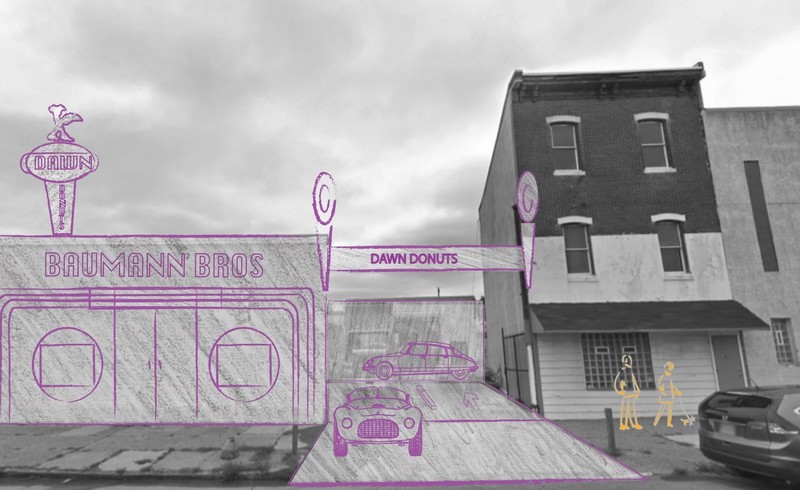
Photo courtesy of Explore Eastern North Philadelphia
Last spring, seniors in Professor Lynn Mandarano’s Community Development Workshop fulfilled their capstone requirement by creating a series of historic walking tours – Explore Eastern North Philadelphia — for the community partner Asociación Puertorriqueños en Marcha. The accompanying exhibition, Exploring Eastern North Philadelphia: Students and Community Engagement, highlighting the student work, is now on display in the Charles Library.
Over a three-year period, students in the Community Development Workshop course examined the changing landscape of Germantown Avenue, Lehigh Avenue, and North 5th Street neighborhoods from 1950 onward, with the students emphasizing the disparity between a change in population, infrastructure, and neighborhood trends.
The project posed and then answered two major questions:
How do we uplift businesses and residents that are already there and bring them together with new developers in order to meet a mutually satisfying goal? How do we create activities where residents can learn about their neighborhood’s history and how disinvestment has hurt the community?
Students worked with Josue Hurtado, Coordinator of Public Services and Outreach at the Charles Library’s Special Collections Research Center, to find old news clippings, historical photographs, and historic city guides. He also walked them through the digitized Philadelphia Inquirer and keyword searches. Most images in the project’s final visuals came from the Special Collections Research Center.
With the information gathered, students developed historic posters, maps, brochures and a website for three walking tours that profile the area’s past vibrancy and cultural identity. The exhibition includes a handful of printed posters and maps of notable sites on each walking tour. Some historical sites featured are Germantown Avenue’s Washington Hotel, which was open from 1892-1975, and F. W. Woolworth Co., open from 1910-1962.
The interactive website was created to complement the walking tours, which could easily be self-guided during the COVID-19 pandemic. The historic posters hung along Germantown Avenue, the first walking tour created in spring 2020, included QR codes linking the posters to additional content on the website.
To incorporate community outreach, Mandarano’s students brought large posters of the maps and photos of the historic sites to a Community Storytelling Workshop to gain a better understanding of the longtime residents who have lived along the “commercial corridor,” and build relationships with the people who remember forgotten businesses.
Resident interviews were also conducted as part of the project, and notable quotes that capture the essence of the thriving community can be found in the exhibition.
One quote from resident Yolanda Coles reads, “I remember that the architecture of the African American Museum was just gorgeous. It had similar colors to the Philadelphia Art Museum — like teal and gold colors. I was shocked when they knocked it down. The museum was never open during my teenage years so I never got the chance to see the inside.”
2018 saw a sudden upswing in proposed development of these neglected and vacant areas, ignoring the community’s longstanding rich history. Asociacion Puertorriquenos en Marcha, the non-profit organization serving the residents of this neighborhood, invited Dr. Mandarano and her students to create this series of community engagement activities to explore the shared history and identity of the community and consequences and potential of new development. The payoff from this level of community outreach can be measured in the appreciation and dedication that Mandarano’s students put into their work paired with the level of interest residents expressed while sharing their stories and learning more about the history of their area.
You can view Exploring Eastern North Philadelphia: Students and Community Engagement in the first-floor exhibition room in the Charles Library, and a virtual version on the STELLA Gallery website.